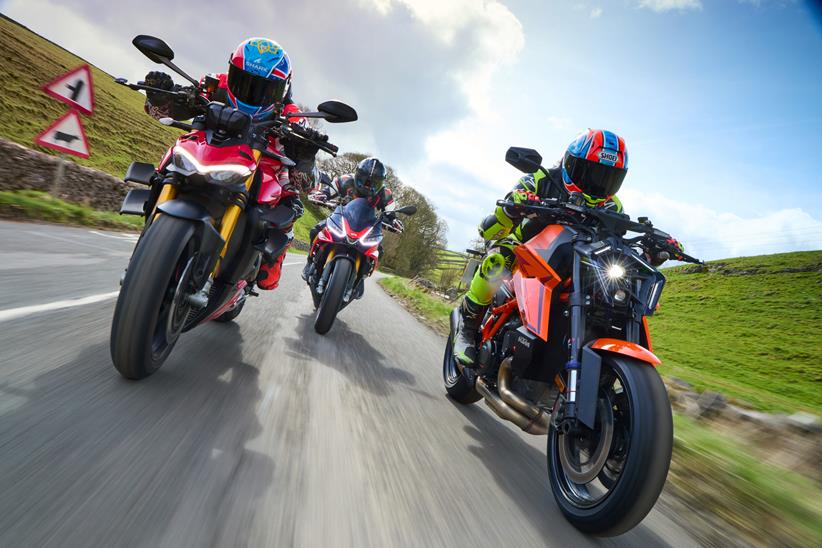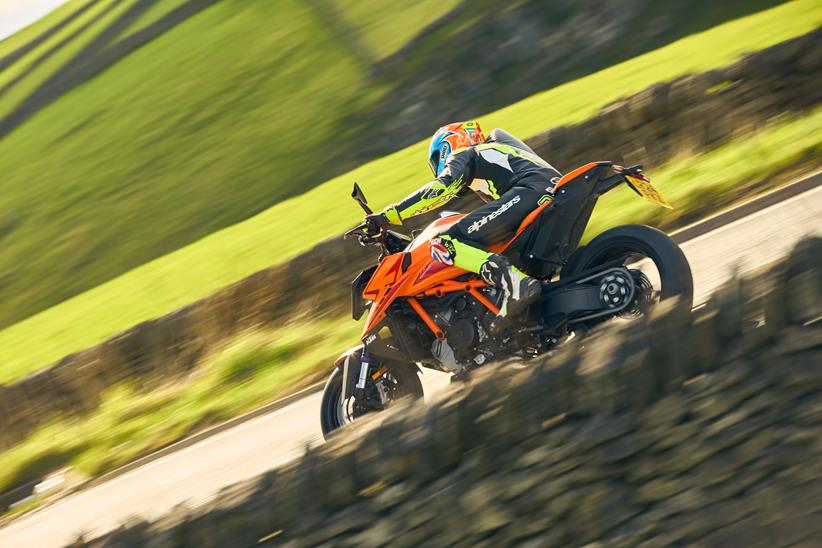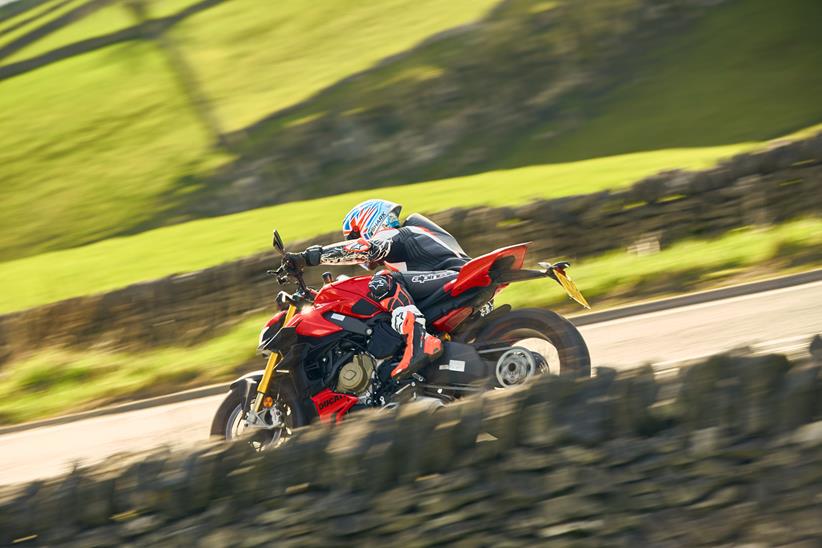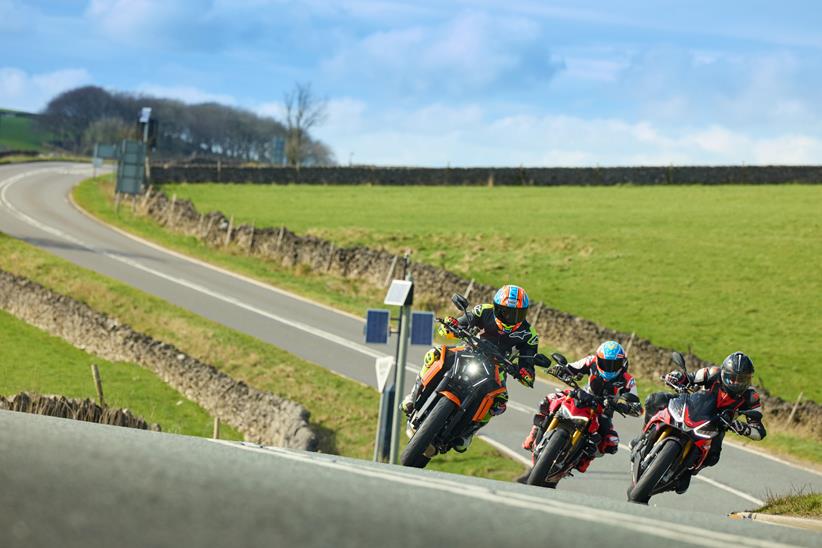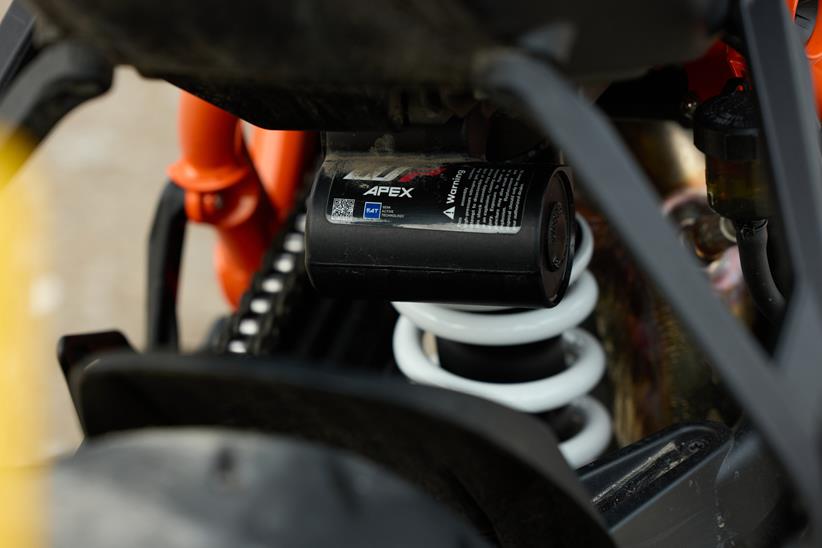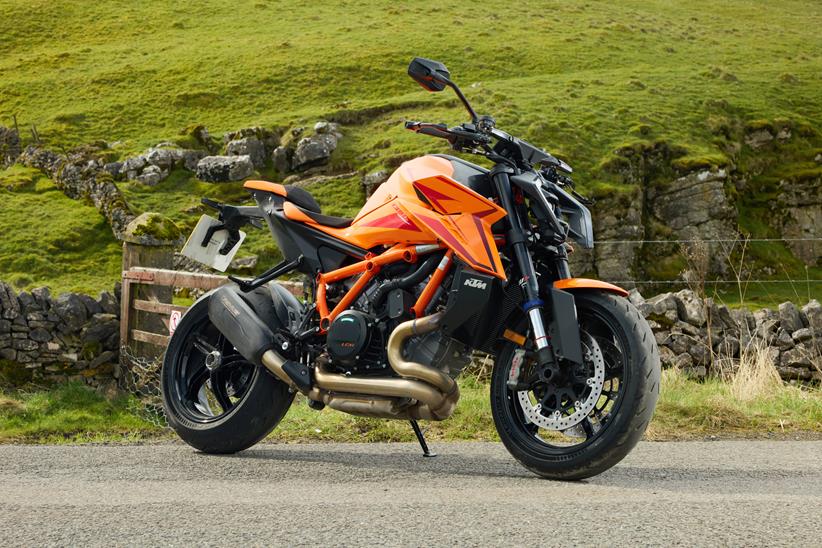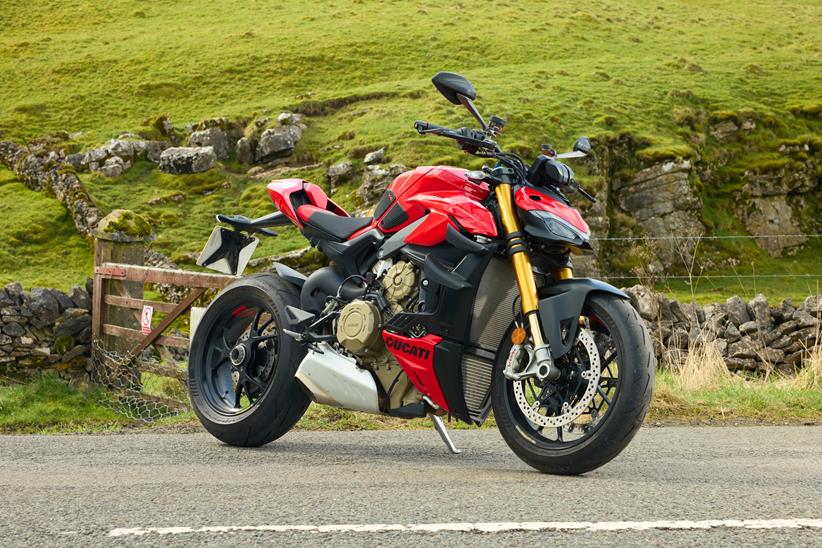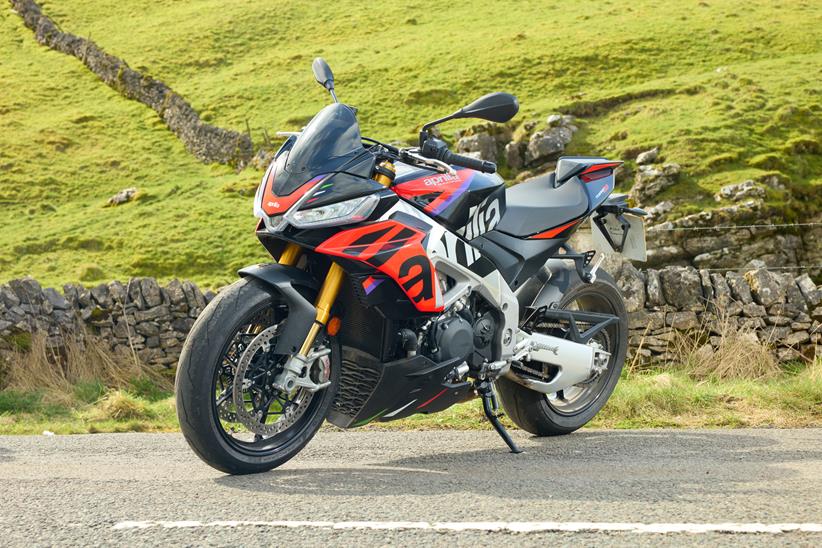Think the KTM 1390 Super Duke R Evo is the cream of the super-naked crop? It's time to find out...
Last month we got the chance to ride KTM’s new 1390 Super Duke R at its world launch. In an intense, testosterone-fuelled track frenzy at the Almeria circuit in southern Spain, we squeezed five 20-minute sessions into a single morning with barely a chance to catch our breath.
An assault on the senses and muscles, the orange super-naked is beyond rapid, rails through corners like a superbike, pulls fourth-gear wheelies off the clutch and has more braking power than your muscles can stand within a few laps.

That’s all well and good but riding flat-out doesn’t reveal a road bike’s true character. That’s why our test today is less frantic track action and wild KTM brochure shots and more how you ride when you’re out with your mates. On our trip to the Peaks, we want to see what’s really changed in the KTM’s switch from the outgoing 1290 to the new 1390 Super Duke R. The bike we have today is the Evo version with semi-active WP suspension costing £1600 more than the standard model.
Super-naked rivals
We also want to find out how it stacks up against the cream of the super-naked crop: the Aprilia Tuono V4 Factory 1100 and Ducati Streetfighter V4 S. If you’re wondering where the KTM’s other top-spec rivals are, consider this – forget lap times, because a great super-naked needs two things: sublime handling and a motor that’s interesting, fun and involving at road speeds. The Aprilia, Ducati and KTM tick these boxes in style.

Fast facts:
KTM 1390 Super Duke R Evo
- Engine 1350cc V-twin, 177.8bhp, 98.5lb.ft
- Frame Steel trellis
- Suspension 48mm WP Apex USD forks and rear shock, fully adjustable
- Front brake 320mm discs with four piston Brembo Stylema radial caliper. Cornering ABS
- Rear brake 240mm disc with twin-piston caliper. Cornering ABS
- Seat height 834mm
- Kerb weight 212kg
Ducati Streetfighter V4 S
- Engine 1103cc V4m 181.9bhp, 79.9lb.ft
- Frame Aluminium ‘front frame’. Engine stressed member
- Suspension Öhlins NIX 43mm forks and single TTX rear adj preload, semi-active damping
- Front brake 2 x 330mm front discs with four-piston Brembo Stylema. Cornering ABS
- Rear brake 245mm rear disc with twin piston caliper. Cornering ABS
- Seat height 845mm
- Kerb weight 203.9kg
Aprilia Tuono V4 Factory
- Engine 1077cc V4, 159.9bhp, 82.3lb.ft
- Frame Aluminium twin-spar
- Suspension Öhlins NIX 43mm forks and TTX36 rear shock. Mechanically adjustable preload, semi-active damping
- Front brake 2 x 330mm front discs with four-piston Brembo M50 calipers. Cornering ABS
- Rear brake 220mm rear disc with twin piston caliper. Cornering ABS
- Seat height 825mm
- Kerb weight 211.8kg
Dyno comparison
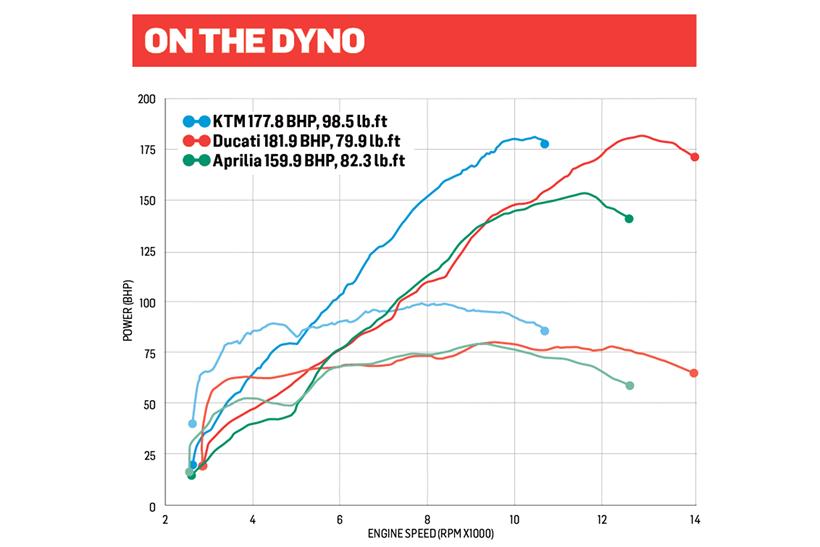
A Yamaha MT-10SP, meanwhile, has a sublime crossplane crank engine in an OK chassis. Despite a dyno-verified 196bhp at the rear wheel, BMW M1000R’s inline four power delivery is forgettable and its chassis too stiff and Triumph’s Speed Triple 1200RS is a filling-shaker on bumpy roads.
Supermoto genes
You could never accuse the KTM of being forgettable. It feels like a giant motocrosser and positively encourages you to play the fool with clever electronics that facilitate perfectly-balanced skids, wheelies and stoppies on track.
Super Dukes have always been playful, but what sets the new 1390 apart from previous versions is just how smooth, friendly and easy to ride it is. Its V-twin engine grows 49cc to 1350cc and KTM claim a 10bhp boost to 187bhp, although a dyno test reveals it’s actually a smidgen down on power and torque.

No matter, because with a rear-wheel 178bhp it isn’t exactly short of oomph and now its delivery feels more like a smooth V4 than a thudding great V-twin. It never clatters or shudders at low speed and it’s loaded with so much grunt that short-shifting through the gears yields the best results.
And, just like standing next to a festival bass speaker, the Super Duke’s airbox and exhaust growl rumbles through you when you open the throttle.
Smooth operator
The motor is deliciously refined, which is amazing when you think it’s just two giant pistons (up from 108mm to 110mm diameter) doing all the work. How KTM have made such a powerful twin so linear through the revs is impressive and its new variable inlet valve timing system must take some credit.
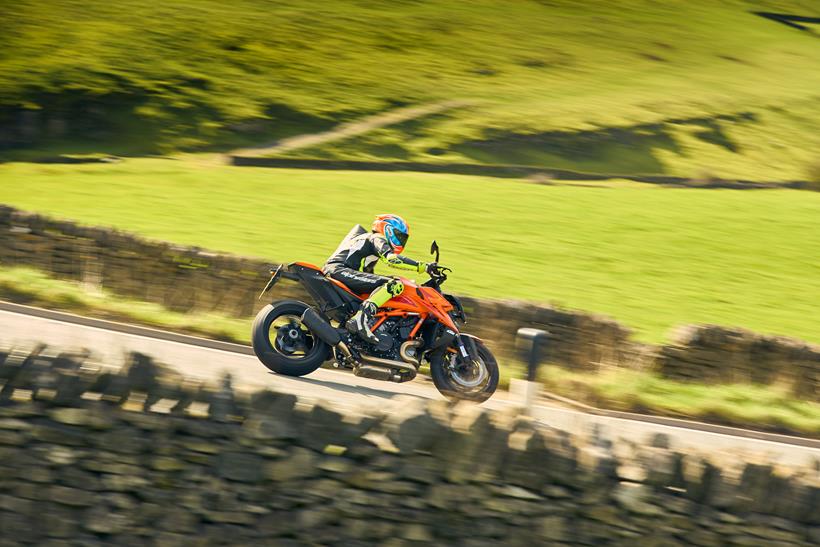
Below 5570rpm the engine’s ‘cam shift’ (similar to BMW’s Shiftcam) runs on mild cams before the high-performance cams kick in. Better still, the cam changeover happens at slightly different revs between the two cylinders to smooth the transition. It works beautifully with no VTEC-like steps in the power delivery.
Sea of silicone
New electronic rider aids are impressive, from riding modes that give you the perfect amount of power you need for the conditions, to traction control that keeps you safe, ABS that lets you back-it-in and a five-stage wheelie control that’ll hold you on one wheel. A two-day road test isn’t enough time to get to know the seemingly endless rider mode permutations and combinations available, but we will when we start putting serious miles on this very 1390 in MCN’s longterm test fleet this year.

ABS, rider modes, tyre pressure monitoring, cruise control, self-cancelling indicators are standard. When demo mode runs out after 900 miles, you’ll need to shell out to reinstate the up/down quickshifter, adjustable traction and wheelie control. You can buy the electronic aids separately or in packs, which for our test bike costs just over a grand.
Sophisticated ride
Electronics also control the Evo’s semi-active suspension. New WP forks and rear shock deliver a plusher, more controlled ride than ever and the shock has self-levelling preload that never allows the rear to sag, no matter how much you weigh or what load you put on the back. As a result, the KTM always keeps its shape, composure and crisp steering. Standard-issue Michelin Power Cup trackday tyres have superb grip, too, but they take a while to warm-up on the road and with so few grooves, need to be handled with care in heavy rain.
Tall riders will love the KTM’s spaciousness, although those with short legs will be on tiptoes at a standstill and the new lower bar position is placed nicely to be sporty, but never wristy. For the duration of our test, the 1390 is never uncomfortable, although our test bike is fitted with a comfort accessory seat (£171.30). We can’t vouch for the standard one, but if you want the last word in sportsbike comfort it’s worth getting all the same.

The fuel tank is reshaped for better knee grippage and is 1.5 litres bigger than before, so as well as being the most frugal here, the KTM does the most miles between fill-ups. It’s also very naked with zero wind protection at speed, but then that’s what it says on the tin and KTM offer a selection of accessory screens from £90.54.
Sometimes riding this tall but very short super naked makes you feel like a naughty youth on a field bike and its pathological eagerness to play won’t always be what some will want. Knocking on the door of £20k, without all the electronic bells and whistles, it isn’t cheap.
Duke versus Duke
Waxing lyrical about the new KTM hasn’t left much time to talk about the Aprilia and Ducati, but we’ve tested them many times before. The Streetfighter V4 S was updated last year with smoother electronics, a lighter lithium battery, bigger fuel tank and a claimed 205bhp from its MotoGP-derived V4, although it makes 182bhp on our dyno.

It’s a wonderful creation with luxurious attention to detail and a rarefied air of specialness compared to the more business-like KTM and Aprilia. That goes a long way to justifying its eye-watering price.
It only makes four bhp more than the Super Duke R, but it feels a lot more. Its engine is a gloriously loud, aggressive monster of a thing and with its twin-pulse firing order feels and sounds more V-twin-like than the KTM.
You need a heavy dose of clutch slip to keep it rolling smoothly at low speed. It’s a serious machine designed to be elegant, handle beautifully and is wickedly fast from A to B. Its wings, counter-rotating crank and an army of electronics are designed to keep the Ducati’s front wheel welded to the tarmac, which is great for lap times, but it lacks playfulness as a result.

If you’re a MotoGP fan, it’s the red Pecco Bagnaia to the orange Brad Binder, which is why it finishes behind the Super Duke in our test. It has a big thirst for fuel, too, and the fact you don’t benefit from heated grips or cruise control is unforgivable for the price.
Feel the V4 force
That brings us to the beautifully rounded Aprilia V4 Tuono Factory. It had its last update three years ago with Euro5 engine mods, uprated electronics, revised styling and wings, plus a bigger fuel tank and an underbraced swingarm taken from the RSV4 superbike.

The Tuono looks a bit long in the tooth now and its colour dash isn’t as svelte as those fitted to its rivals, but get on board and wow, what a machine it still is. The Aprilia can be as playful as the KTM or as single-minded as the Ducati. It’s the least powerful here, making ‘just’ 160bhp at the back wheel (and a claimed 173bhp), but performance is never lacking on the road and the bike’s wailing V4 soundtrack is pure MotoGP-spec.
It has the best ride quality of any sportsbike you care to mention, with semi-active Öhlins suspension that turns any road surface into the finest crushed velvet. The front end has so much feel it encourages you to pile into corners even harder than on the other two machines and braking performance is the best here. Its neutral riding position is a joy for any size rider and, unlike the Ducati, the Aprilia doesn’t get impatient when you ride it slowly.

The Aprilia has been a consistent group test winner since it grew from a 1000 to an 1100 in 2015 and although the new KTM runs it close, the Tuono V4 Factory 1100 is still the money-no-object super-naked to beat. Best of all for 2024 Aprilia have slashed the list price from £18,100 to £16,700 and it’s a huge amount less a month than the Ducati and KTM a month on PCP which means more cash for fuel and tyres.
The MCN Verdict: ‘The Aprilia is still king’
KTM’s new 1390 Super Duke R Evo is more refined than ever. Its bigger V-twin engine is now so smooth it feels more like a V4 than some actual V4s and suspension upgrades come close to endowing it with the impeccable ride quality of an Aprilia Tuono V4 Factory 1100.

We know the Super Duke is quick on track, but it’s also a joy to ride at road speeds. Its engine is characterful, handling crisp, braking power strong and its demented supermoto hooligan genes are never far away when you want to have fun. It’s comfy and spacious, too, although shorter riders may struggle at a standstill. It’s more playful and cheaper than the hugely competent, but serious Ducati, but it still can’t match the all-round class act that is the Aprilia. It’s getting on now, but the Tuono’s wailing V4 engine, plush ride and heavenly front end are hard to beat – and it’s also way cheaper to buy, too.
Likes:
- KTM’s new-found smoothness
- Aprilia’s all-round fun
- Ducati’s speed and build quality
Dislikes:
- KTM can be too single-minded
- Ducati’s salty price tag
- Aprilia clocks are starting to look dated
While you’re here: How MCN tests bikes
Our highly experienced team of road testers grind out hundreds of miles, come rain or snow, on the UK’s pothole-ridden roads to decide which bike is best in a particular category.
Using years of riding and racing experience (on and off-road), our expert journalists are able to assess the capabilities of a machine and translate that into understandable language to help MCN’s readers make an informed buying decision. Pitching bikes against their main rivals, we aim to give a conclusive verdict on which bike is best for your needs and your budget.
Using their considerable knowledge of the motorcycling market and audience, they can put a motorcycle into context and deliver a verdict that means something to anyone considering buying a particular machine, whether it be a cutting-edge, 200bhp sportsbike, a tall adventure weapon or a low-capacity 125cc machine.
When we ride the bikes in the UK we tend to do at least one full day of riding on various different types of road and in varying conditions. Our testers will then spend another day riding the bike – with rivals – to get images and video footage for our print and online reviews.
We will also, often, weigh the bikes, speed and dyno test them to see just how accurately the manufacturer claims are in these areas to give a more empirical assessment.
